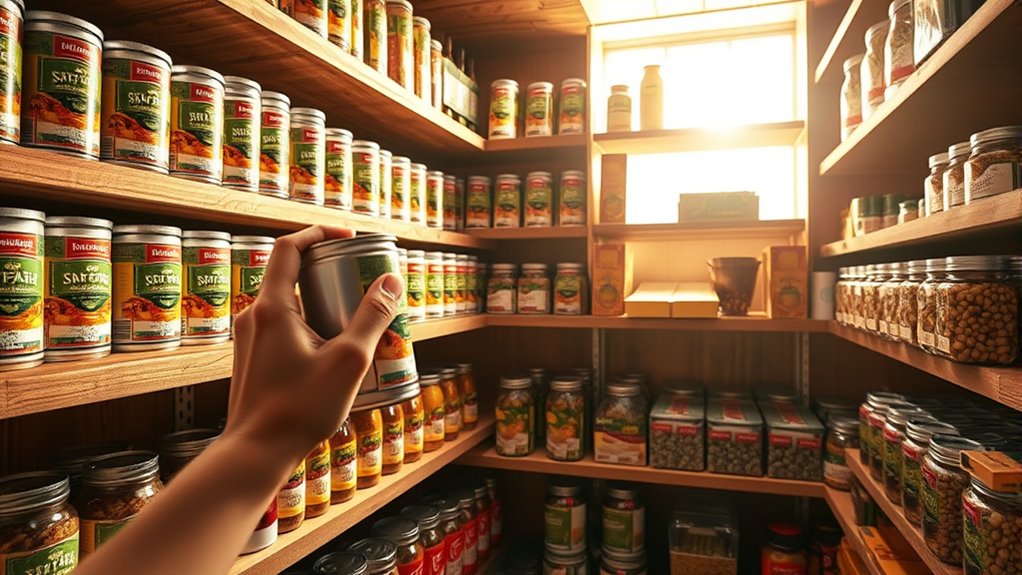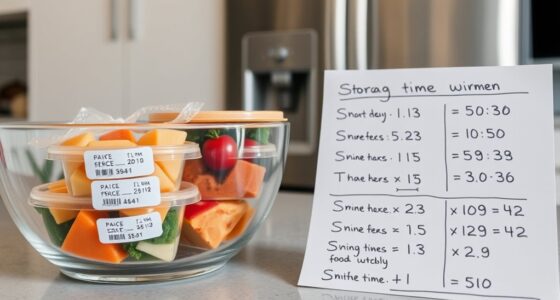To go from zero to confident with your non-perishable pantry, start by evaluating your needs and setting clear goals based on your lifestyle and dietary restrictions. Choose versatile, high-quality items with long shelf lives, organize your supplies efficiently, and create a simple plan for shopping and restocking. Keep your pantry well-maintained by rotating stock and tracking expiration dates. If you keep these tips in mind, you’ll soon master building a budget-friendly, reliable pantry that serves you well—more details await you.
Key Takeaways
- Assess your dietary needs and lifestyle to determine essential non-perishable items and set achievable pantry goals.
- Focus on versatile, long-lasting staples like rice, beans, and canned vegetables to maximize utility and shelf life.
- Organize your pantry with clear labels, airtight containers, and categorized sections for easy access and inventory management.
- Implement regular stock rotation, expiration checks, and a simple restocking schedule to maintain freshness and prevent shortages.
- Use budget-friendly strategies such as shopping sales, bulk buying, and opting for store brands to build confidence and savings.
Assessing Your Needs and Setting Goals
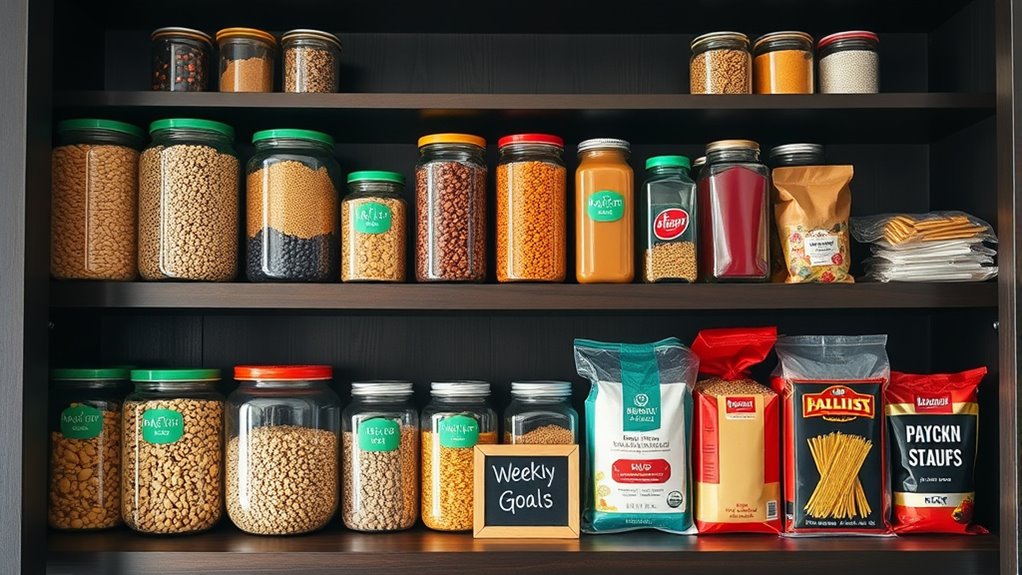
Have you ever wondered how much non-perishable food you actually need to keep on hand? Evaluating your needs starts with understanding your lifestyle and meal prep habits. Think about how often you cook at home and whether you prefer quick, ready-to-eat meals or more elaborate dishes. Consider any dietary restrictions—gluten-free, vegetarian, or allergy-related—that influence your choices. Setting clear goals helps prevent overstocking and ensures you have the right items for your meals. Make a list of essential items based on your preferences and restrictions. This way, you’ll create a practical pantry that supports your routines, reduces waste, and keeps you prepared for unexpected situations. Tailoring your stock to your needs makes pantry planning efficient and stress-free.
Choosing the Right Non-Perishable Items
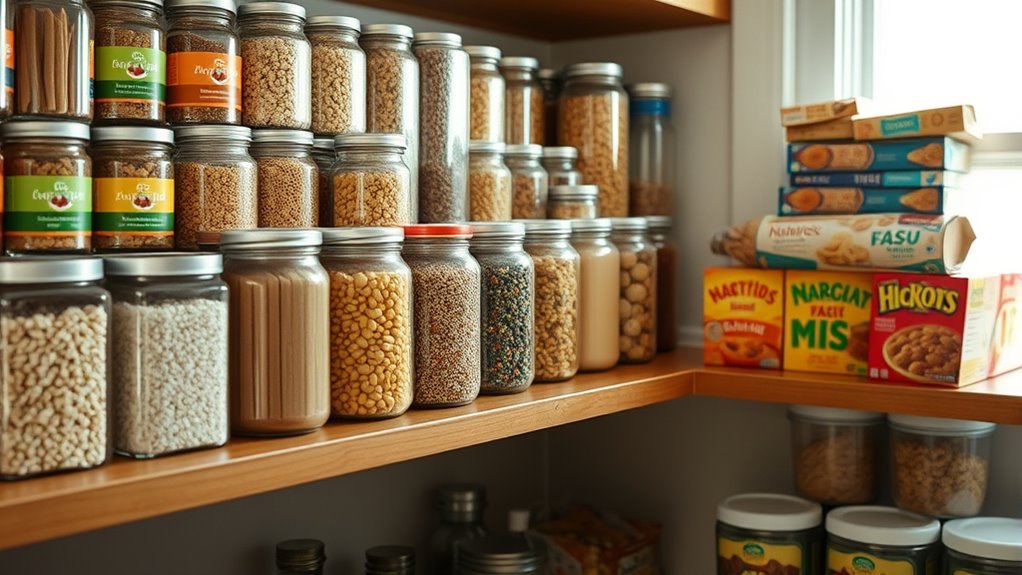
Choosing the right non-perishable items is essential for building a functional pantry that meets your needs. Focus on versatile ingredients that support meal prep and flavor pairing, making your cooking easier and more enjoyable. Stock staples like rice, pasta, canned beans, and shelf-stable proteins, which can be combined in numerous ways. Consider spices, herbs, and sauces to enhance flavor and create variety. Think about your favorite cuisines and incorporate those ingredients to keep meals exciting. Opt for items with long shelf lives and good nutritional value, avoiding impulse buys that don’t serve your goals. Additionally, understanding the power output of electric bikes can help you choose the right motor for your needs, whether for commuting or off-road adventures. By selecting carefully curated ingredients, you’ll set the foundation for quick, delicious meals and ensure your pantry supports your cooking style and preferences.
Organizing Your Pantry for Efficiency
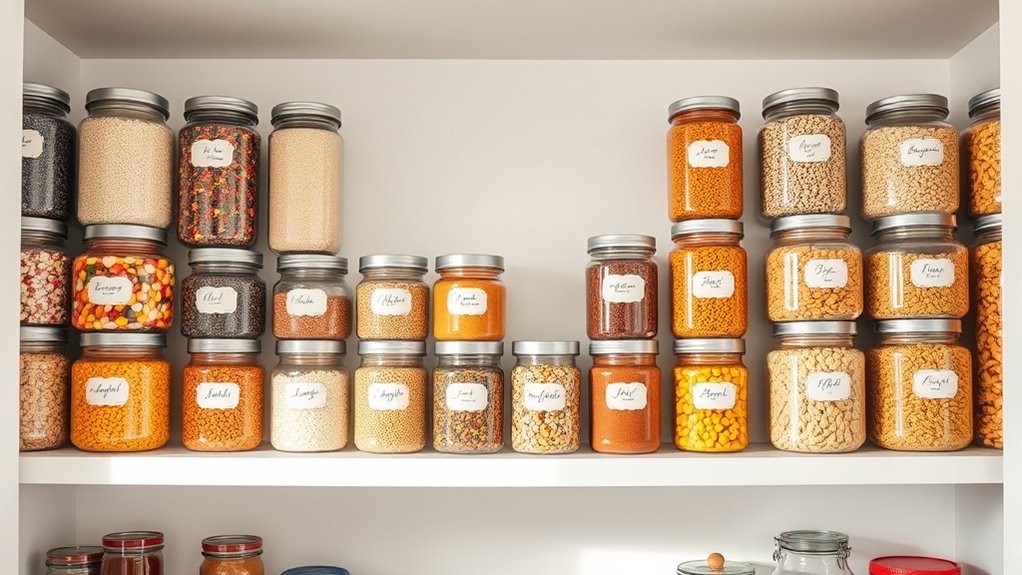
Organizing your pantry for efficiency starts with sorting your items into clear categories so you can find what you need quickly. Using transparent containers helps you see what’s inside and keeps everything tidy. Make sure to regularly rotate your stock to prevent expiration and keep your supplies fresh. Incorporating proper labeling can further streamline access and maintain organization.
Categorize Your Items
Why is it important to categorize your pantry items? Clear categories make it easier to find what you need quickly, saving time during meal prep and reducing stress. Group similar items together, like canned goods, baking supplies, and snacks, so you know exactly where everything is. This organization helps you keep track of your emergency supplies, ensuring you always have essentials on hand. When your pantry is properly categorized, you can identify shortages before they become urgent and avoid overbuying. It also streamlines your shopping list, making restocking more efficient. Plus, a well-organized pantry keeps everything neat and accessible, encouraging you to cook more confidently and maintain your non-perishable stock effortlessly. Implementing proper categorization techniques can further enhance your pantry management and improve overall kitchen efficiency.
Use Clear Containers
Have you ever struggled to find the right item quickly in your pantry? Using clear containers makes it easier to see what you have at a glance. Opt for airtight storage options to keep your non-perishables fresh and prevent pests. Clear containers also help you avoid unnecessary rummaging, saving you time and frustration. Implement a label system on each container, so you know exactly what’s inside without opening them. This keeps your pantry organized and boosts efficiency. Choose uniform sizes for stacking and easy access. Regularly check your containers for freshness and refills. Incorporating proper storage guidelines ensures your pantry remains functional and organized over time. By using clear, airtight storage with a consistent label system, you create a streamlined pantry that’s both functional and visually appealing. This simple step makes stocking and accessing your non-perishables effortless.
Regularly Rotate Stock
Keeping your pantry organized isn’t just about neatness; it’s about guaranteeing you always have fresh ingredients on hand. Regularly rotating your stock helps you do this by preventing expired items from lurking at the back. Check expiration dates frequently and move older items to the front, so they’re used first. Proper storage conditions are key—store items in cool, dry places to extend their shelf life. When you rotate stock, you also identify any items that are nearing their expiration date, reducing waste. This habit keeps your pantry efficient and ensures you’re always cooking with fresh, safe ingredients. Staying on top of expiration dates and maintaining ideal storage conditions makes your pantry a reliable resource, saving you time and money in the long run. Proper storage not only preserves the quality of your food but also promotes a healthier environment by reducing spoilage and waste.
Creating a Simple Shopping and Restocking Plan
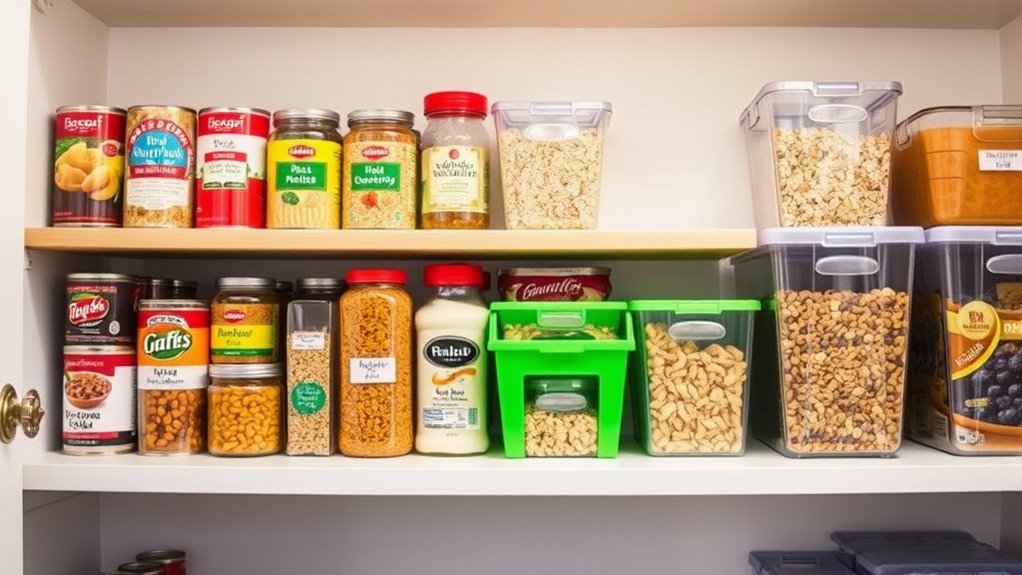
To keep your pantry stocked efficiently, start by identifying your essential items and making them a priority. Set a schedule to restock these items regularly, so you never run out unexpectedly. With a simple plan in place, you’ll save time and avoid last-minute trips.
Prioritize Essential Items
When creating a shopping and restocking plan, focusing on essential items guarantees your pantry remains functional during emergencies or busy times. Start by identifying staple foods like canned beans, rice, and pasta, which form the foundation of your meals. Don’t forget snack options such as granola bars or nuts, which provide quick energy. Beverage choices like bottled water, tea, or coffee are also critical for hydration and comfort. Prioritize items with long shelf lives and high nutritional value to ensure you can sustain yourself without frequent trips. Keep a running list of these essentials, so shopping becomes faster and more efficient. Incorporating storage solutions can help you organize your pantry effectively and keep track of your stock levels. By concentrating on these key items, you’ll build a reliable pantry that supports your needs during any situation.
Schedule Regular Restocks
Creating a straightforward schedule for restocking your pantry helps guarantee you won’t run out of key items when you need them most. Regularly planning shopping trips ensures your emergency supply planning stays on track and your meal prep strategies remain effective. Set a consistent interval—weekly or biweekly—to check inventory and replenish staples before they run low. Keep a list of essentials that need frequent restocking and adjust based on your consumption. This routine helps prevent last-minute shopping and keeps your pantry organized. Being aware of your consumption patterns can help you better tailor your restocking schedule to your needs. By sticking to a simple plan, you reduce stress during emergencies and streamline your shopping process. Consistent restocks also give you peace of mind, knowing your non-perishable stockpile supports both daily meals and unexpected situations.
Tips for Budget-Friendly Pantry Building
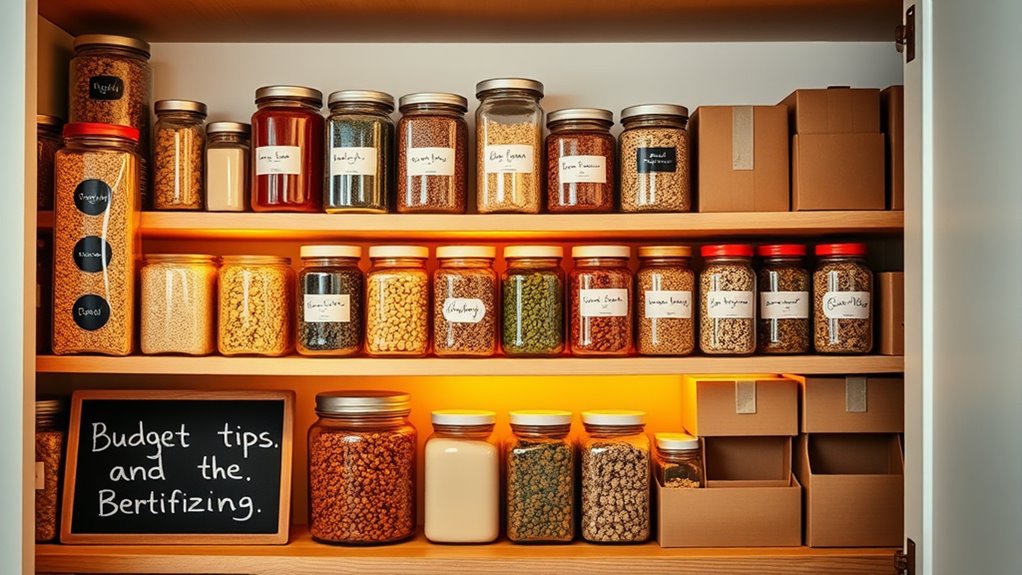
Building a budget-friendly pantry is all about strategic planning and smart shopping. Start by making a meal prep plan to identify essential ingredients, preventing impulse buys. Use budget tracking tools or apps to monitor your spending and stay within your limits. Shop sales and discounts, and buy non-perishables in bulk when possible, which saves money over time. Focus on versatile staples like rice, beans, and canned vegetables that can be used in multiple recipes. Avoid buying pre-packaged items, which tend to be more expensive. Keep an eye out for store brands—they’re usually of similar quality but at lower prices. Incorporate top-rated pantry staples into your shopping list to ensure you are choosing high-quality, long-lasting items. With careful planning and diligent tracking, you’ll build a pantry that’s both affordable and stocked with essentials for any meal.
Maintaining and Updating Your Stock
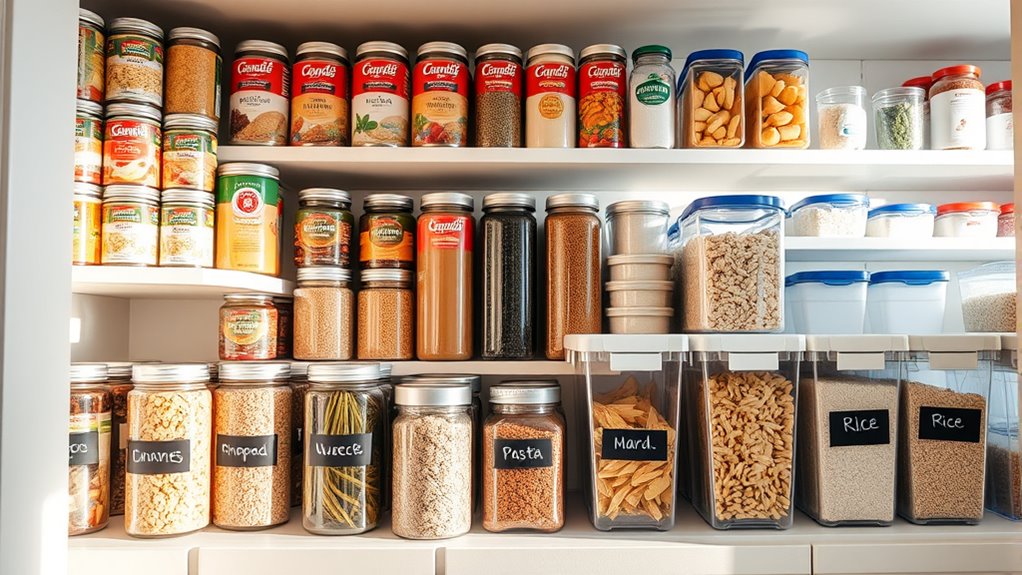
Regularly maintaining and updating your stock guarantees your pantry stays fresh and ready for use. Use a labeling system to keep track of expiration dates and contents, ensuring nothing goes to waste. Transfer items into clear, airtight storage containers to preserve quality and simplify access. Check your inventory weekly, rotating older items to the front. This habit prevents spoilage and helps you identify shortages early. Keep a simple chart or list to monitor what needs restocking. Staying vigilant about cybersecurity vulnerabilities in your inventory management tools can prevent potential data breaches. Here’s an emotional snapshot of your efforts:
| Fresh Start | Organized Space | Peace of Mind |
|---|---|---|
| Confidence | Clear Labels | No Waste |
| Preparedness | Easy Access | Security |
| Satisfaction | Less Clutter | Control |
Stay consistent, and your pantry will remain a reliable resource for years.
Troubleshooting Common Pantry Challenges
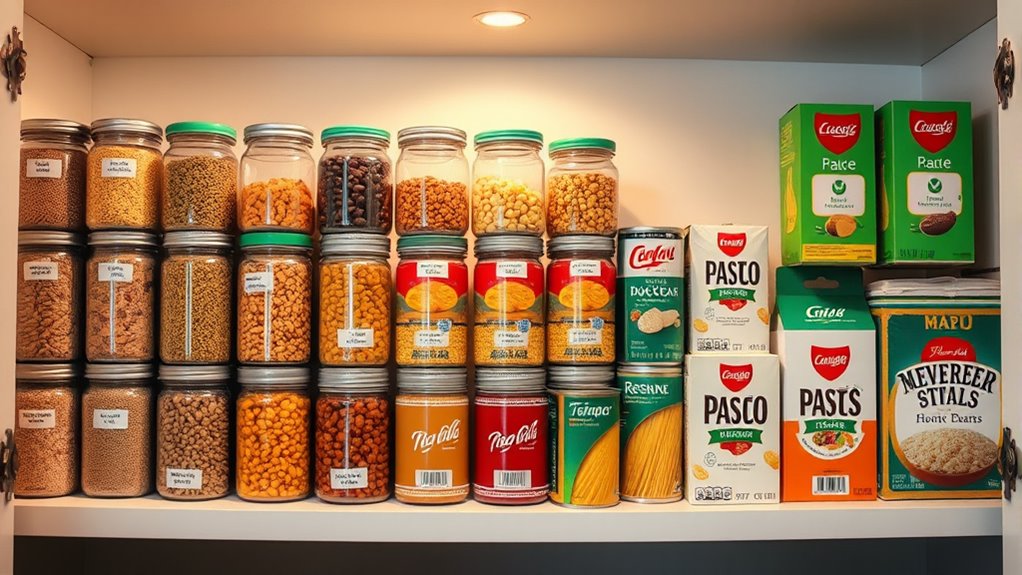
Even with a well-organized pantry, challenges can still arise that disrupt your food storage routine. One common issue is spoilage due to improper storage conditions, which can shorten the shelf life of your non-perishable items. To prevent this, guarantee your pantry remains cool, dry, and dark, as heat and humidity accelerate deterioration. Sometimes, items may become outdated or lose quality before their expiration date, often due to poor labeling or neglecting to rotate stock. Regularly check your pantry and discard anything past its shelf life or showing signs of spoilage. Keep items in airtight containers to maintain freshness and protect against pests. Troubleshooting these challenges involves maintaining ideal storage conditions and staying vigilant about expiration dates, ensuring your pantry remains reliable and well-stocked. Additionally, understanding emotional support can help you stay motivated and resilient while managing these tasks.
Frequently Asked Questions
How Long Can Different Non-Perishable Items Typically Last?
Most non-perishable items last 6 months to 2 years, depending on the type. Canned goods can last 1-5 years, while dried pasta and rice stay good for 1-2 years. Check expiration dates regularly and store items in a cool, dry place away from sunlight. Proper storage tips, like airtight containers, help extend shelf life and ensure your pantry stays fresh and safe to eat.
What Are Some Creative Ways to Use Canned Goods?
Canned goods are your pantry’s hidden gems waiting to shine. Get creative with pairings like tuna with spicy salsa or chickpeas in a warm curry. Use shelf life hacks to turn leftovers into new dishes—think hearty salads with beans or roasted vegetables topped with tomato sauce. Mix and match flavors to keep meals exciting and extend the life of your staples, transforming simple cans into culinary treasures.
How Do I Prevent Pantry Pests and Spoilage?
To prevent pantry pests and spoilage, follow key storage tips like keeping your cans and dry goods in airtight containers. Regularly check for signs of pests or damage, and store items in a cool, dry place away from sunlight. Use bay leaves or pest repellent sachets as natural pest prevention methods. Proper organization and cleanliness help keep your pantry safe and extend the shelf life of your non-perishable foods.
What Are the Best Storage Containers for Non-Perishables?
You should choose storage containers with airtight seals to keep pests and moisture out. Opt for those with a stackable design to maximize space and keep your pantry organized. Look for BPA-free, clear containers so you can easily see what’s inside. Durable, leak-proof, and easy to open containers will make your non-perishable pantry more accessible and help extend the shelf life of your food.
How Can I Incorporate Non-Perishables Into Daily Meals?
You can incorporate non-perishables into your daily meals by using them in meal prep and snack ideas. Mix canned beans or lentils into salads or rice bowls for quick, nutritious lunches. Keep shelf-stable nuts, dried fruits, or granola handy for easy snacks. Use canned vegetables in pasta or casseroles, and stock up on dried fruits or trail mix for energy boosts throughout the day. This keeps your meals convenient and varied.
Conclusion
Think of your pantry as a garden—you start with a plan, plant the right seeds, and tend to it regularly. When you stock smartly and stay organized, your pantry blooms with confidence and ease. Remember, even seasoned gardeners hit a few weeds—so don’t be discouraged by small setbacks. With patience and consistency, your pantry will grow into a reliable, stress-free resource, turning everyday meals into effortless, confident choices.
